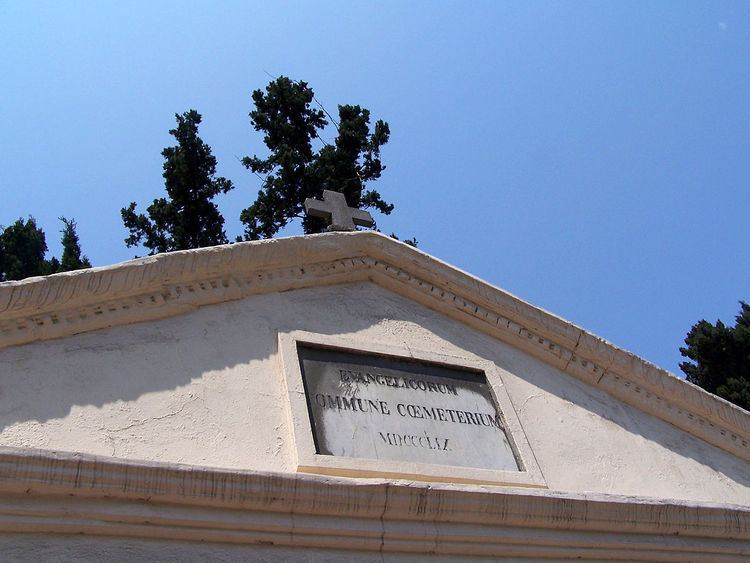Established 1859 Founded 1859 | Style 19th century European | |
 | ||
Address Cumhuriyet Mahallesi, Abide-i Hürriyet Cd No:5, 34380 Şişli/İstanbul, Turkey | ||
Feriköy Protestant Cemetery (Turkish: Feriköy Protestan Mezarlığı) officially called Evangelicorum Commune Coemeterium is a Christian cemetery in Istanbul, Turkey. As the name of the cemetery indicates, it is the final resting place of Protestants residing in Istanbul. The cemetery is at Feriköy neighborhood in Şişli district of Istanbul, nearly 3 km (1.9 mi) north of Taksim Square.
Contents
The land for this cemetery was donated in 1857 by the Ottoman government to the leading Protestant powers of that time, the United Kingdom, Prussia, the United States, the Netherlands, Sweden, Norway, Denmark and the Hanseatic League.
In Istanbul, all members of the Reformed Churches belong to the Protestant Cemetery in Feriköy. Burial sites are being distributed by the Consulate General. Since its opening, a total of roughly 5,000 individuals have been interred at the site. Resembling a museum of funerary art, the cemetery contains examples of different styles of monuments and memorials from the 17th century to the present.The stones proper up along the walls are one of the last tangible links to the old Frankish burial ground in the Grand Champs des Morts, Pera's 'Great Field of the Dead' which was lost in the wake of urban expansion during the 19th century. The consuls general of Germany, the United Kingdom, the United States, the Netherlands, Sweden, Hungary and Switzerland have the duty of managing the cemetery. They exchange the task of management biennially.
History
Between 1840 and 1910, the area of Istanbul stretching northward from Taksim to Şişli was transformed from open countryside to densely inhabited residential settlement. Early 19th century maps of Istanbul show much of the area in this direction taken up by the non-Muslim burial grounds of the Grand Champs des Morts, with the Frankish section directly in the path of the main route of expansion. The urban development in the Ottoman capital, influenced by Western models, led to the closure of the Grand Champs des Morts - Istanbul's `City of the Dead', a world-renowned necropolis, which had provided inspiration, as well as an ideal, for the cemetery reformers of Europe.
Already by 1842, this burial ground was being whittled down, as a contemporary account by Reverend William Goodell attests. One of the founders of the American Board of Commissioners for Foreign Missions to the Armenians at Istanbul, Goodell had lost his nine-year-old son, Constantine Washington, to typhoid fever in 1841 and buried him in the Frankish section of the Grand Champs des Morts.
From the memoirs of Reverend William Goodell on February 18, 1842 : On account of the encroachments on the Frank burying ground, I had to remove the body of our beloved boy. The grave had been dug deep, and the coffin was scarcely damp. Every thing was sweet and still. The new grave which we have prepared a few rods distant was also deep and dry; and there we laid the body, to rest in its quiet bed till the resurrection morning. Beloved child, farewell!
However, little Constantine's tranquility lasted far less than expected, disturbed again by a flurry of construction in the early 1860s. In July 1863, the remains of more than a dozen Americans, including those of Constantine Washington Goodell, were exhumed from the old Frankish burial ground in the Grand Champs des Morts. They were transferred, along with their grave markers, to a new Protestant cemetery in Feriköy - created by order of Sultan Abdülmecid I in the 1850s - for re-interment.
The land occupied by the former burial ground was turned into a public park (in a modern Western sense), a project finally completed six years later with the opening of Taksim Garden in 1869.
The first body was interred at the new site in November 1858, but the cemetery did not official open until early in 1859. Although the burial ground was created primarily for foreign nationals, a separate section in the southwest corner is reserved for Armenian Protestants.
There is one Commonwealth war grave, of an officer of the British Army Intelligence Corps, who died during World War II in 1945.
The Armenian Protestant section
The burial plot reserved for Armenian Protestants is separated by a wall from the main cemetery where foreign Protestants are laid to rest, since Armenians were regarded as "Ottoman subjects". In this small section, there are also some graves belonging to Greeks, Arabs, Assyrians and Turkish Protestants most of whom are former Muslims that converted to Protestantism with epitaphs written in five different languages.
Selected notable burials
A few of the notables buried here are:
